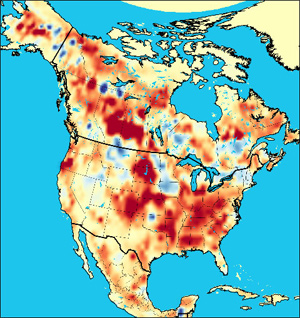East coast forests are most important carbon sink in North America
Drought hurts carbon sinks in North America
mongabay.com
November 26, 2007
East coast forests are most important carbon sink in North America
A new system for tracking carbon uptake in North America, shows that deciduous forests along the East Coast (32 percent) and the boreal coniferous forests (22 percent) of northern Canada absorbed the bulk of carbon dioxide emissions between 2000 and 2005, but suggests that climate change may increasingly affect carbon sinks, according to research published in the journal Proceedings of the National Academy of Science.
CarbonTracker, a U.S. government-backed atmospheric monitoring system that continuously measures atmospheric carbon dioxide, allows scientists to track carbon flux of North American ecosystems on a daily basis. Using data from the system, Wouter Peters of the National Oceanic and Atmospheric Administration Earth System Research Laboratory and colleagues found that North American land absorbed between 0.4 and 1.0 petagrams of carbon (PgC) per year, partially offsetting the annual 1.85 PgC released by fossil fuel burning and cement manufacturing. The authors note that terrestrial uptake fell to 0.32 PgC/yr during the large-scale drought of 2002, suggesting that carbon sinks are sensitive to climate extremes.
 The 2002 summer carbon uptake anomaly due to excessive drought #1. The figure shows areas where excessive droughts have reduced natural carbon uptake in the terrestrial biosphere during the summer of 2002. |
“In our 5-yr estimate, 2002 stands out as a particularly low net uptake year (0.32 PgC/yr) in North America, with only about half of the sink of the other years,” write the authors. “This phenomenon is apparent in both the temperate (0.32 PgC/yr) and boreal (0.0 PgC/yr) zones and seems unrelated to emissions from fires in 2002 [0.065 PgC across North America]. This suggests that the balance of photosynthesis and respiration was modified this year, likely driven by drought. In 2002, North America experienced one of the largest droughts in over a century with conditions over nearly 45% of the United States classified as ‘Extreme’ or ‘Exceptional’… in the U.S. Drought
Monitor.”
Peters and colleagues say several factors influence terrestrial CO2 sink, but that “land-use history has been identified as the major determinant of regional terrestrial uptake.”
“Large sinks can be found, for instance, in forests recovering from logging in the past century, as well as on abandoned agricultural lands recovering
from past carbon losses,” they write. “Increased fire suppression and changes
in agricultural methods have also led to increased carbon storage in the soils and biosphere. These factors combined may be the cause of the strong uptake we calculate over the East Coast of the United States, in the Canadian coniferous forests, and across the grass and croplands of the Midwest.”
The researchers say that while “CarbonTracker marks a significant step in our
ability to monitor month-by-month surface sources and sinks of CO2,” the system takes an “atmospheric view” and doesn’t account for all carbon flux.
“Large net uptake seen in areas dominated by croplands (0.11 PgC/yr) may be due to the ‘atmospheric view’ we take with CarbonTracker. Over agricultural lands, our system sees strong CO2 uptake during the growing season but a much smaller return flux from respiration during the non-growing season,” they write. “The difference can be explained by harvesting of crops and their subsequent transport, which is a substantial term in the carbon budget… The harvested crops are returned to the atmosphere after consumption spread across the country as a much smaller source per unit area. Because CarbonTracker was not built to
keep track of lateral transport, this source is most likely assigned to regions with large population densities, whereas croplands remain annual mean net absorbers of carbon in the Midwest even though the soil carbon accumulation over these areas is thought to be small.”
CITATION: Wouter Peters et al (2007). An atmospheric perspective on North American carbon dioxide exchange: CarbonTracker. PNAS November 27, 2007 vol. 104 no. 48